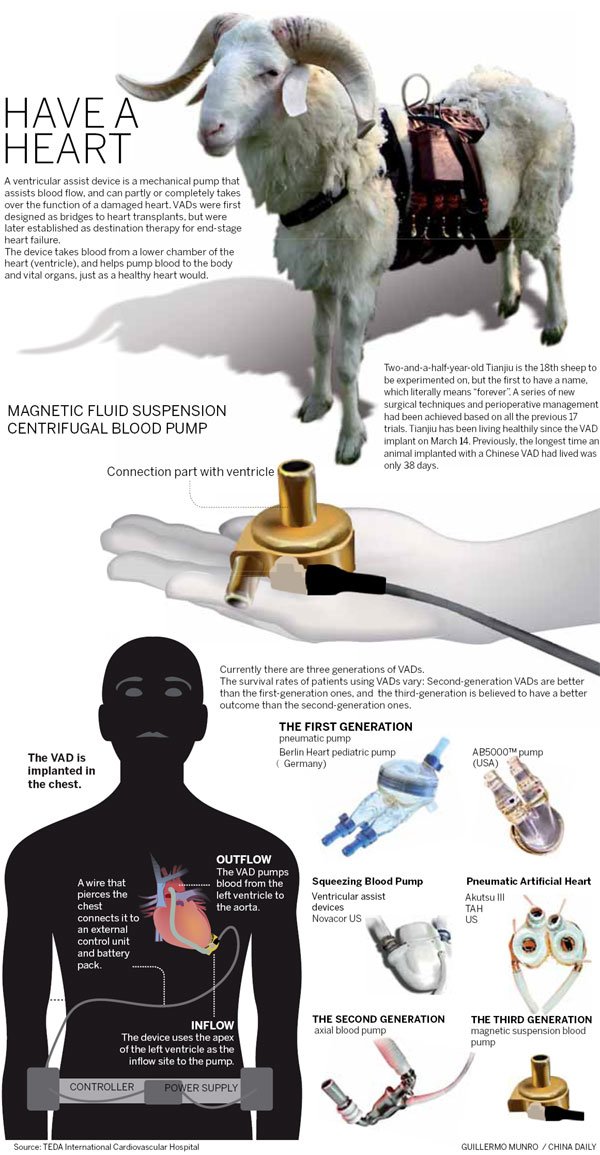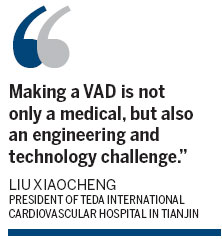Baa, baa, lab sheep
Updated: 2013-06-19 07:44
By Liu Zhihua (China Daily)
|
||||||||

There are many celebrity animals, but at the moment, none is more famous in China than a woolly creature that lives in Tianjin. Liu Zhihua has the story.
At the TEDA International Cardiovascular Hospital in Tianjin, there is a very famous animal of the woolly persuasion. His name is Tianjiu, a sheep whose name has hogged headlines in the mainstream media, and whose photograph went viral on the Internet.
The 2.5-year-old animal is famous because he is wearing a ventricular assist device (VAD) that was developed and made in China and is doing very well. The device was implanted on March 14, and Tianjiu is still living, healthily.
Previously, the longest time an animal implanted with a Chinese VAD had lived was only 38 days.
The hospital launched the program in 2009, together with a branch institute of China Academy of Launch Vehicle Technology.
"Such a successful trial has never been done before in China. It is absolutely a great breakthrough," says Liu Xiaocheng, president of the hospital and team leader of the VAD program.
"Based on this success, we are going to carry out group animal trials and then clinical human trials when we get approval from health authorities. We will likely find a permanent treatment for heart failure through the use of VADs."
Heart failure is a worldwide medical issue. The condition occurs when the heart cannot pump enough blood to cater for a healthy body. A heart transplant is currently the only reliable treatment for end-stage heart failure.
Patients waiting for a heart transplant may not last until they find a suitable donor, because demand always exceeds supply, Liu says.
Because of this, many doctors see VAD as an alternative lifeline for people with end-stage heart failure, especially when the patient cannot have a heart transplant.
In China, there is an estimated population of 16 million heart failure patients currently, many of whom are in the end stage. However, only about 100 heart transplants are conducted each year, Liu notes.
VAD is a mechanical pump that assists blood circulation and can partly or completely take over the function of a damaged heart, Liu adds.

Since the first VAD got United States Food and Drug Administration's approval in 1994 for clinical use, some countries, including the US, Japan and Germany, have developed various VADs and have used them either as a bridge to heart transplants, or as alternative therapy.
Although scientists in Beijing implanted VADs in animals as early as in the 1980s, about a decade later after similar experiments in the US, China had yet to develop its own domestically produced VADs for clinical tests.
"Making a VAD is not only a medical, but also an engineering and technology challenge," Liu says. "We lag behind international levels, although a lot of professionals have invested effort for the cause."
To meet the needs of a VAD user, the design must be based on a perfect medical understanding of the mechanism of the heart, heart failure, its causes, symptoms, progressive stages and so on. An artificial device would need to address the health problems and avoid undesirable results.
It is the engineers' job to make a device out of the design - not easy, because it takes time, energy and experience to realize the functions the design requires, and minimize mechanism-related incidences, and decide what material and technology to use.
A computer-aided testing system is also needed to virtually test the design to modify it, and the effectiveness of such a test is dependent on the reliability of the hardware and software system involved.
"The design is like a draft blueprint drawn by the medical team, and only the closest cooperation and communication between the medical team and the engineers can make the design come true," says Zhang Jiemin, director of the animal trial center at the hospital.
"Any negligence on either team will lead to failure."
The VAD the hospital has designed is a new type that few countries have. It will be smaller, with greater stability and efficiency, but less likely to cause infection, thrombosis, or limit the users' daily activities.
By this reckoning, it is more demanding on both the medical and engineering teams.
Tianjiu, the sheep, was the 18th animal to be tried on the program. All former trials had failed.
With the VAD implanted, the ram is healthy and cheerful, and apparently enjoying his high profile. He poses for the cameras when there are visitors taking pictures.
He also has the company of another sheep, whose grandmother and mother were also trial subjects.
Tianjiu literally means "forever", and the hospital hopes the sheep will live a healthy life to a ripe old age.
The hospital plans to carry out clinical trials in a year, and hopefully there will be good results, according to Liu Xiaocheng, the hospital president.
His optimism is not shared by all, and Yuan Biao, a cardiac surgeon with No 1 Hospital of Tsinghua University says he believes locally made VADs will not be as good as those now widely used in foreign countries, at least not in the near future.
He feels there is too much of a gap in technology. But he applauds the current efforts, saying it is necessary for China to develop its own VADs.
Contact the writer at liuzhihua@chinadaily.com.cn.
(China Daily 06/19/2013 page19)

 'Taken 2' grabs movie box office crown
'Taken 2' grabs movie box office crown
 Rihanna's 'Diamonds' tops UK pop chart
Rihanna's 'Diamonds' tops UK pop chart
 Fans get look at vintage Rolling Stones
Fans get look at vintage Rolling Stones
 Celebrities attend Power of Women event
Celebrities attend Power of Women event
 Ang Lee breaks 'every rule' to make unlikely new Life of Pi film
Ang Lee breaks 'every rule' to make unlikely new Life of Pi film
 Rihanna almost thrown out of nightclub
Rihanna almost thrown out of nightclub
 'Dark Knight' wins weekend box office
'Dark Knight' wins weekend box office
 'Total Recall' stars gather in Beverly Hills
'Total Recall' stars gather in Beverly Hills
Most Viewed
Editor's Picks

|

|

|

|

|

|
Today's Top News
Shenzhou X astronaut gives lecture today
US told to reassess duties on Chinese paper
Chinese seek greater share of satellite market
Russia rejects Obama's nuke cut proposal
US immigration bill sees Senate breakthrough
Brazilian cities revoke fare hikes
Moody's warns on China's local govt debt
Air quality in major cities drops in May
US Weekly

|

|








